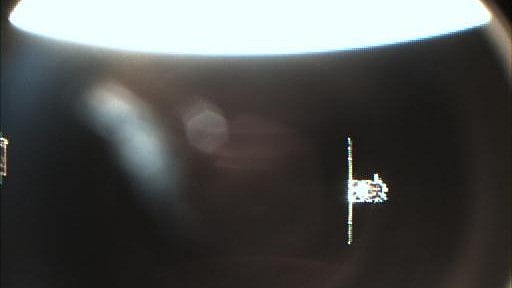
SpaDeX satellites holding position at 15m
Credit: X/@isro
Chennai: Treading cautiously, the Indian Space Research Organisation (ISRO) on Sunday conducted a trial by bringing two Space Docking Experiment (SpaDeX) satellites to a three 3 metre distance but moved them back to a safe distance to “analyse the data” before docking them on the space.
Sunday’s development demonstrates the challenges and complexities involved in mastering the art of docking satellites, a feat, if achieved, would allow India to join the select club of US, China, and Russia. The agency on Sunday morning brought the satellites to a distance of 15 metres – both the spacecraft captured “stunning photos and videos” of each other, raising hopes of conducting the experiment.
However, the agency said it was only a trial and data collected from it will be analysed thoroughly by scientists before docking the satellites. No timeline has been announced by the ISRO for the docking experiment after it missed the January 10 window period.
“A trial attempt to reach up to 15 metres and further to 3 metres is done. Moving back spacecrafts to a safe distance. The docking process will be done after analysing data further,” the space agency said in a terse update, without divulging further details.
ISRO seems to be cautious over its approach as it wants to take time to conduct the experiment successfully rather than doing it in haste. The agency, which was to carry out the experiment on January 7, postponed it to January 9 after identifying an abort scenario.
Hours before the docking experiment on January 9, the agency found out that the drift between the two spacecraft was more than expected and postponed it once again. Since January 8 night, ISRO scientists worked overtime to correct the drift and arrested the satellites at an inter-satellite distance of 230 metres on Saturday.
SpaDeX mission, which was launched on December 30 from Sriharikota, is extremely crucial for India’s future missions to the space like Chandrayaan-4, the country’s fourth unmanned lunar mission, the manned mission to mission, Gaganyaan, sample return from the moon, and the building and operation of the planned Bharatiya Antariksh Station (BAS).
The mission is aimed at developing and demonstrating crucial technology required to dock and undock spacecraft in space. It will also demonstrate several indigenous technologies, including a sophisticated docking mechanism, rendezvous and docking sensors, power transfer technology, and inter-satellite communication link (ISL) for autonomous communication between spacecraft.
After successful docking and rigidisation, electrical power transfer between the two satellites will be demonstrated before their undocking and separation to start the operation of their respective payloads for the expected mission life of up to two years, scientists said, adding that in-space docking technology is essential when multiple rocket launches are required to achieve common mission objectives.
Owing to its small size and mass, SpaDeX is even more challenging due to the finer precision required for the rendezvous and docking manoeuvres compared to docking two large spacecraft. “This mission will be a forerunner for autonomous docking needed for future lunar missions like Chandrayaan-4 without the support of GNSS from Earth,” the ISRO said.
The payloads include a high resolution camera mounted on SDX01 to capture the process of rendezvous, docking and undocking, while SDX02 carries a miniature multi-spectral payload (MMX) whose imaging is useful for natural resource monitoring and vegetation studies and a radiation monitor to measure radiation dose encountered in space.